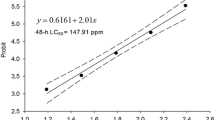Abstract
Male Chinese loaches were exposed to 17β-estradiol (E2) and nonylphenol (NP) both singly and in combination for 42 days using semi-static waterborne exposure system. Plasma vitellogenin (Vtg) was chosen as determining endpoint. The results demonstrated that 0.5 μg/L E2 could induce the enhancement of Vtg contents in male Chinese loaches after exposure for 21 days, which showed a time-related increasing manner; NP was also estrogenic to male Chines loach, and the vitellogenic responses showed in a time-and dose-related manner, which was less potent than that of E2. The binary mixtures of E2 and NP can significantly elicit the production of Vtg in male Chinese loaches, which was more potent than that of individual compounds, and Vtg induced in the binary mixture groups was higher than the summation of Vtg induced in the corresponding single-compound groups at the same concentration.
Similar content being viewed by others
References
Pillon A, Boussioux A M, Escande A, et al. Binding of estrogenic compounds to recombinant estrogen receptor-α: Application to environmental analysis. Environ Health Perspect, 2005, 113(3): 278–284
Jobling S, Sumpter J P. Detergent components in sewage effluent are weakly estrogenic to fish: An in vitro study using rainbow trout (Oncorhynchus mykiss) hepatocytes. Aquat Toxicol, 1993, 27(3–4): 361–372
Jobling S, Sheahan D, Osborne J A, et al. Inhibition of testicular growth in rainbow trout (Oncorhynchus mykiss) exposed to estrogenic alkylphenolic chemicals. Environ Toxicol Chem, 1996, 15(2): 194–202
Tremblay L, Van Der Kraak G. Use of a series of homologous in vitro and in vivo assays to evaluate the endocrine modulating actions of β-sitosterol in rainbow trout. Aquat Toxicol, 1998, 43(2–3): 149–162
Christensen L J, Korsgaard B, Bjerregaard P. The effect of 4-nonylphenol on the synthesis of vitellogenin in the flounder Platichthys flesus. Aquat Toxicol, 1999, 46(3–4): 211–219
Schwaiger J, Mallow U, Ferling H, et al. How estrogenic is nonylphenol? A transgenerational study using rainbow trout (Oncorhynchus mykiss) as a test organism. Aquat Toxicol, 2002, 59(3–4): 177–189
Chikae M, Ikeda R, Hasan Q, et al. Effect of alkylphenols on adult male medaka: plasma vitellogenin goes up to the level of estrous female. Environ Toxicol Phar, 2003, 15(1): 33–36
Pait A S, Nelson J O. Vitellogenisis in male Fundulus heteroclitus (killfish) induced by selected estrogenic compounds. Aquat Toxicol, 2003, 64(3): 331–342
Kanno, S, Hirano S, Kayama F. Effects of phytoestrogens and environmental estrogens on osteoblastic differentiation in MC3T3-E1 cells. Toxicology, 2004, 196(1–2): 137–145
Heppell S A, Denslow N D, Folmar L C, et al. Universal assay of vitellogenin as a biomarker for environmental estrogens. Environ Health Perspect, 1995, 103(Suppl 7): 9–15
Sumpter J P, Jobling S. Vitellogenesis as a biomarker for estrogenic contamination of the aquatic environment. Environ Health Perspect, 1995, 103(Suppl 7): 173–178
Kime D E, Nash J P, Scott A P. Vitellogenesis as a biomarker of reproductive disruption by xenobiotics. Aquaculture, 1999, 177(1–4): 345–352
Marin M G, Matozzo V. Vitellogenin induction as a biomarker of exposure to estrogenic compounds in aquatic environments. Mar Pollut Bull, 2004, 48(9–10): 835–839
Shao J, Shi G Q, Jin X L, et al. Development and validation of an enzyme-linked immunosorbent assay for vitellogenin in Chinese loach (Misgurnus anguillicaudatus). Environ Int, 2005, 31(5): 763–770
Lv X F, Shao J, Song M Y, et al. Vitellogenic effects of 17β-estradiol in male Chinese loach (Misgurnus anguillicaudatus). Comp Biochem Physiol C, 2006, 143(1): 127–133
Van den Belt K, Verheyen R, Witters H. Comparison of vitellogenin responses in zebrafish and rainbow trout following exposure to environmental estrogens. Ecotoxicol Environ Saf, 2003, 56(2): 271–281
Pedersen S N, Christiansen L B, Pedersen K L, et al. In vivo estrogenic activity of branched and linear alkylphenols in rainbow trout (Oncorhynchus mykiss). Sci Total Environ, 1999, 233(1–3): 89–96
Payne J, Rajapakse N, Wilkins M, et al. Prediction and assessment of the effects of mixtures of four xenoestrogens. Environ Health Perspect, 2000, 108(10): 983–987
Rajapakse N, Silva E, Kortenkamp A. Combining xenoestrogens at levels below individual No-observed-effect concentrations dramatically enhances steroid hormone action. Environ Health Perspect, 2002, 110(9): 917–921
Silva E, Rajapakse N, Kortenkamp A. Something from “nothing”-Eight weak estrogenic chemicals combined at concentrations below NOECs produce significant mixture effects. Environ Sci Technol, 2002, 36(8): 1751–1756
Thorpe K L, Cummings R I, Hutchinson T H, et al. Relative potencies and combination effects of steroidal estrogens in fish. Environ Sci Technol, 2003, 37(6): 1142–1149
Brian J V, Harris C A, Scholze M, et al. Accurate prediction of the response of freshwater fish to a mixture of estrogenic chemicals. Environ Health Perspect, 2005, 113(6): 721–728
Rajapakse N, Ong D, Kortenkamp A. Defining the impact of weakly estrogenic chemicals on the action of steroidal estrogens. Toxicol Sci, 2001, 60(2): 296–304.
Panter G H, Thompson R S, Sumpter J P. Intermittent exposure of fish to estradiol. Environ Sci Technol, 2000, 34(13): 2756–2760
Villeneuve D L, Villalobos S A, Keith T L, et al. Effects of waterborne exposure to 4-nonylphenol on plasma sex steroid and vitellogenin concentrations in sexually mature male carp (Cyprinus carpio). Chemosphere, 2002, 47(1): 15–28
Ackermann G E, Schwaiger J, Negele R D, et al. Effects of long-term nonylphenol exposure on gonadal development and biomarkers of estrogenicity in juvenile rainbow trout (Oncorhynchus mykiss). Aquat Toxicol, 2002, 60(3–4): 203–221
Thorpe K L, Hutchinson T H, Hetheridge M J, et al. Assessing the biological potency of binary mixtures of environmental estrogens using vitellogenin induction in juvenile rainbow trout (Oncorhynchus mykiss). Environ Sci Technol 2001, 35(12): 2476–2481
Author information
Authors and Affiliations
Corresponding author
Additional information
Supported by the State High Tech Development Plan (Grant No. 2006AA06Z424), National Basic Research Program of China (Grant No. 2003CB415001), National Natural Science Foundation of China (Grant No. 40503014), and Chinese Academy of Sciences (Grant No. KZCX3-SW-431)
About this article
Cite this article
Lü, X., Zhou, Q., Song, M. et al. Vitellogenic responses of male Chinese loach (Misgurnus anguillicaudatus) exposed to the individual or binary mixtures of 17β-estradiol and nonylphenol. Chin. Sci. Bull. 52, 3333–3338 (2007). https://doi.org/10.1007/s11434-007-0486-4
Received:
Accepted:
Issue Date:
DOI: https://doi.org/10.1007/s11434-007-0486-4




